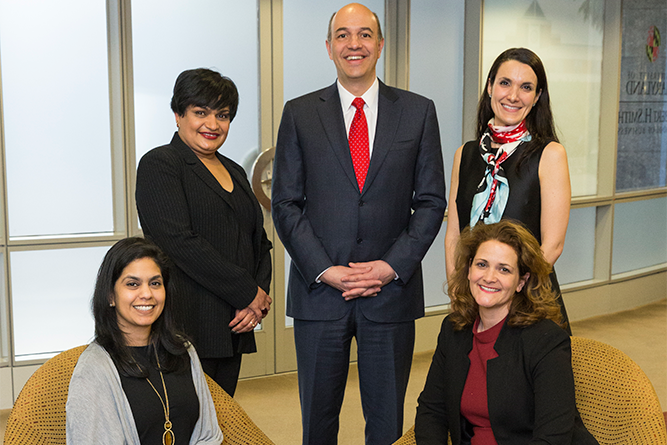
Gender diversity can improve a firm's performance, research shows, but consensus is fleeting as to why a lack diversity persists on corporate boards.
Such was the focus of a March 8, 2017, event, "Gender Diversity on Corporate Boards: How Do We Get There?" – a panel discussion co-organized by the Center for Financial Policy, Ed Snider Center for Enterprise and Markets and Office of Diversity Initiatives from the University of Maryland’s Robert H. Smith School of Business.
Academic, corporate and legal experts gathered on International Women’s Day at the Ronald Reagan Building in Washington, D.C., to discuss factors for the underrepresentation and how companies and stakeholders are influencing greater diversity on boards.
A leaky pipeline is one factor to consider, said Rajshree Agarwal, Lamone Chair and Professor in Entrepreneurship and director of the Snider Center. Women and men are earning bachelor’s degrees at an even rate, but men hold an edge in post-graduate degrees, she noted. Furthermore, women more proportionally enter teaching and professional services, while men are more inclined to position themselves for managerial roles.
Smith School Dean Alex Triantis, in opening remarks, pointed to business schools addressing the roots of the pipeline challenge. He cited the Snider Center’s Women Investing in Learning Leadership program (a summer residency at Smith for high school students) and Cookie College, which brought girl scouts to the Smith School in December for goal-setting and money-management lessons. And, when women enroll, b-schools like Smith (see here) are “networking, mentoring, and helping women understand the impact they can have in organizations at leadership levels,” Triantis said.
“The trends are going in the right direction,” said Agarwal, noting that women now comprise at least 20 percent of boards in half of U.S. Fortune 1000 companies.
Institutional investors by and large are driving these numbers, said Smith adjunct professor Andrew J. Sherman, a partner with Seyfarth Shaw, who teaches corporate governance and business planning to MBAs. “Board effectiveness and protecting the interests of shareholders is a fundamental, driven by innovation, creativity and a true 360-degree perspective” – and diversity happens to fuel the latter, Sherman said. This is driving institutional investors to advocate for gender diversity awareness, "because underrepresentation, now, means missed opportunity." he said.
Panelist Karishma Shah Page, a partner with international law firm KL Gates, said Starbucks, with four female directors on its 13 member board, illustrates Sherman’s point by strategically appealing to younger consumers, who happen to value diversity, as well as sustainability. And connecting with consumers stands to drive shareholder returns.
But Starbucks, soon to add a fifth female director, has been enlarging instead of “refreshing” its board. The panelists agreed the latter is more ideal. Agarwal said recent gains, overall are due to enlargement of boards rather than turnover.
“The trend runs the risk for boards to be unwieldy, unmanageable and increasingly ineffective,” said Sherman. “This [scenario] has the feel of tokenism.”
Panelist Erin Essenmacher, chief programming officer for the National Association of Corporate Directors, said “there’s a real focus on collegiality, which can make refreshing a board difficult.” If industry projections call for replacing a likable and smart director, “it’s actually very hard for boards to do that,” she said. Tenure or term limits can be a solution in this case, she says. But across-the-board measures aren’t very practical, when accounting for such company differences as industry-type and where the firm is in its life cycle.
Sean Quinn, executive director of Institutional Shareholder Services, among the event’s attendees, noted that a recently completed study, commissioned by the Investor Responsibility Research Center Institute and completed by ISS, on board composition and turnover reveals “some of the longest tenured directors are chairs of the nomination committees.” But, on the other hand, “investors are increasingly interested in ‘who are you and why are you here’ in regard to board members,” he said. “Since the financial crisis we have been seeing [underperforming directors] increasingly rotating off boards.”
Sherman said the old-school, or non-gender-diverse board model “is dying,” but “not dead.”
“So, we [in academic settings] need to keep attacking the model,” he said. “Institutional investors are attacking that model. Customers are attacking that model… We're making headway."
Read more: “Women on Boards: Avoiding Tokenism” gives more insight from the March 8 event, via Smith Brain Trust.
This event is part of Smith Women’s Month: go.umd.edu/womensmonth.
- Greg Muraski, Office of Marketing Communications
Media Contact
Greg Muraski
Media Relations Manager
301-405-5283
301-892-0973 Mobile
gmuraski@umd.edu
About the University of Maryland's Robert H. Smith School of Business
The Robert H. Smith School of Business is an internationally recognized leader in management education and research. One of 12 colleges and schools at the University of Maryland, College Park, the Smith School offers undergraduate, full-time and flex MBA, executive MBA, online MBA, business master’s, PhD and executive education programs, as well as outreach services to the corporate community. The school offers its degree, custom and certification programs in learning locations in North America and Asia.